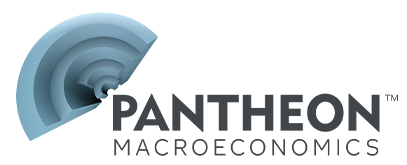US Publications
Below is a list of our US Publications for the last 6 months. If you are looking for reports older than 6 months please email info@pantheonmacro.com, or contact your account rep
Please use the filters on the right to search for a specific date or topic.
Samuel Tombs
- The total federal government payroll probably is on course to be around 200K smaller by October.
- Lost incomes and greater uncertainty point to a bigger 300K total hit to aggregate payroll growth.
- Monetary policy still is meaningfully restrictive, despite the pick-up in M2 growth.
Samuel TombsUS
Decision-making on hold until the federal policy outlook becomes clearer.
Samuel TombsUS
- The S&P PMI points to growth in final sales to private domestic purchasers slowing to just 2% in Q1.
- The PMI was too gloomy during the first trade war, but tariff and federal spending risks are bigger now.
- Tariff threats also are driving consumers’ confidence lower and inflation expectations higher.
Samuel TombsUS
GROWTH IN SPENDING & PAYROLLS TO SLOW MID-YEAR…
- …FALLING SERVICES INFLATION TO OFFSET THE TARIFF BOOST
Samuel TombsUS
- The core CPI-PCE inflation gap likely increased to 0.7pp in January; the relatively big gap will last.
- Tariffs and rising auto insurance premiums will boost the CPI more than the PCE deflator.
- Existing home sales probably dropped in January, marking the start of a sharp fall in Q1 overall.
Samuel TombsUS
- Average temperatures and snow cover were in line with seasonal norms last week, unlike in January.
- Homebase data point to weak February payrolls, but they have become a poor guide; wait for better data.
- Expect a low claims print today, but this week’s bad weather and DOGE job cuts will boost claims soon.
Samuel TombsUS
- An exceptionally cold January likely weighed heavily on housing starts and building permits last month...
- ...but the underlying trend in residential construction activity seems to be softening too.
- CPI food inflation is set to rise further, even if the President decides against substantial new tariffs.
Samuel TombsUS
Disinflation still on track; consistent with 2.6% core PCE inflation, down 0.2pp from December.
Samuel TombsUS
Seasonals still failing to offset new year price rises; February data will reassure the FOMC.
Samuel TombsUS
- PPI and CPI data signal a 0.28% m/m rise in the core PCE deflator and a 0.2pp fall in the inflation rate.
- Inflation likely will be close to 2% by year-end absent more tariffs; labor cost pressures are still easing.
- We look for a sharp fall in manufacturing output in January, driven by adverse weather.
Samuel TombsUS
- Seasonal adjustment has evolved too slowly to offset greater clustering of annual price rises in January.
- Underlying services inflation continues to fall; leading indicators point to further progress.
- Surges in CPI auto insurance and hospital services prices will not feed through to the core PCE deflator.
Samuel TombsUS
- Headline retail sales were probably held back by a plunge in auto sales linked to supply-bottlenecks...
- ...but underlying sales likely were strong again, as tariff threats encouraged pre-emptive purchases.
- Mr. Powell's Humphrey-Hawkins Testimony was unremarkable, but watch for post-CPI comments today.
Samuel TombsUS
- Manufacturers have hiked prices to game pre-tariff demand, but prices for autos and clothing likely fell.
- Revisions to the seasonals should temper the residual seasonality in the services price data.
- New tariffs on steel and aluminum will have minimal impact on overall inflation.
Samuel TombsUS
Positive near-term revisions offset the subpar January print; a March easing is off the table.
Samuel TombsUS
- The recent upward inflexion in payroll growth likely will be tempered by revisions...
- ...But January’s numbers likely were depressed by bad weather; expect a better print in February.
- A mid-year slowing in payroll growth still looks likely, but we now look for the FOMC’s next easing in June
Samuel TombsUS
Trend still low for now; leading indicators paint a mixed picture.
Samuel TombsUS
Poor track record suggests ADP’s resilient picture should be disregarded.
Samuel TombsUS
- Output per hour rose an impressive 2.3% in 2024; surveys point to higher IT spending by firms in 2025.
- AI spending, however, poses near-term downside risks to employment and more disinflation pressure.
- Mixed signals on federal spending so far, but DOGE likely will drag slightly on demand and employment.
Samuel TombsUS
Labor demand still deteriorating, amid tight monetary policy and elevated uncertainty.
Samuel TombsUS
- March 2024 payrolls likely will be revised down by about 670K after benchmarking to UI records...
- ...The birth-death model’s contribution to payroll growth since then probably will be revised down too.
- We see some evidence of tariff “front-running” in December trade data; expect a lot more to come.
Samuel TombsUS
